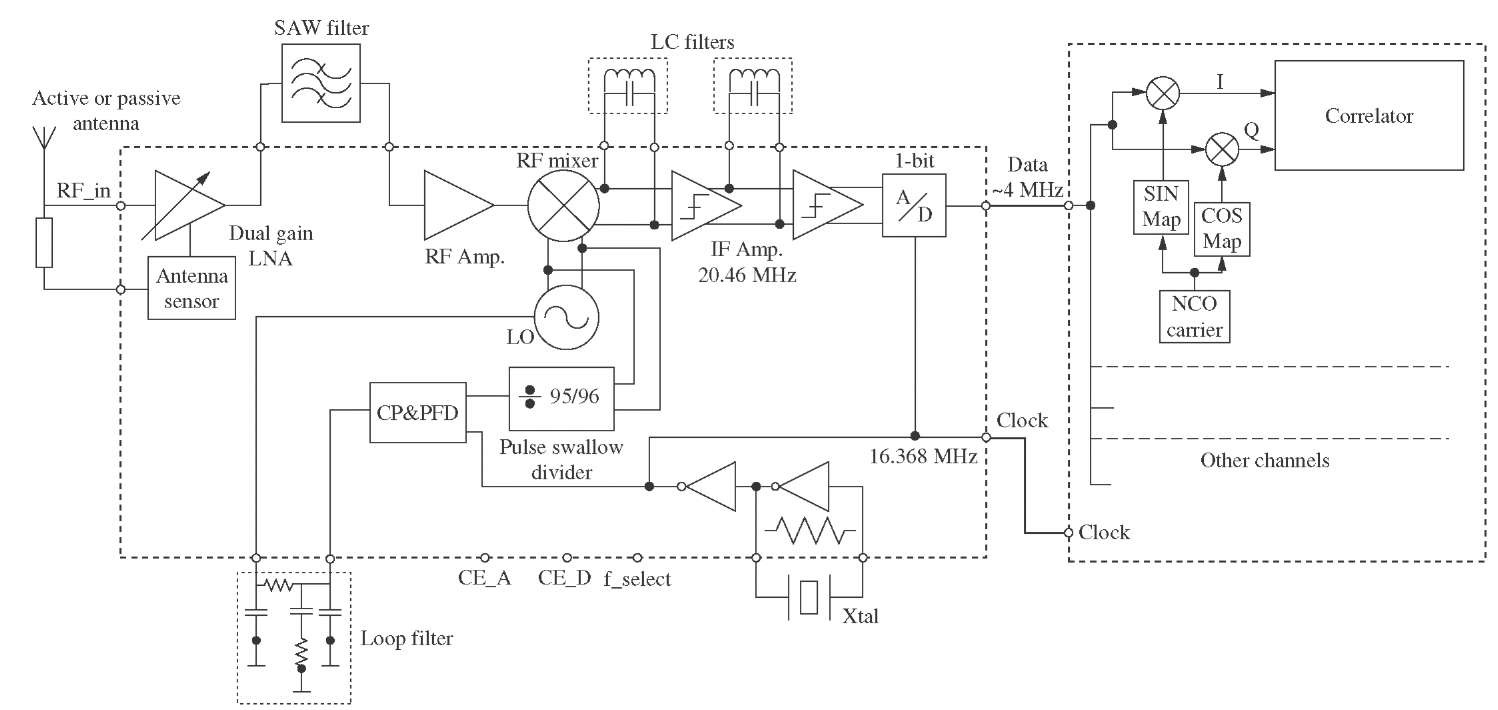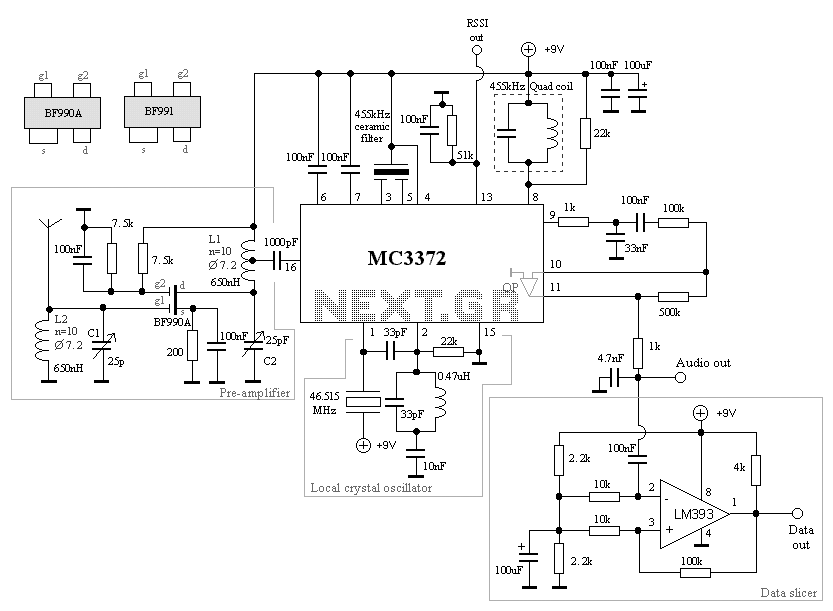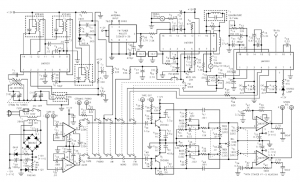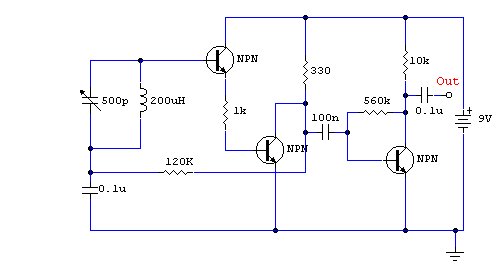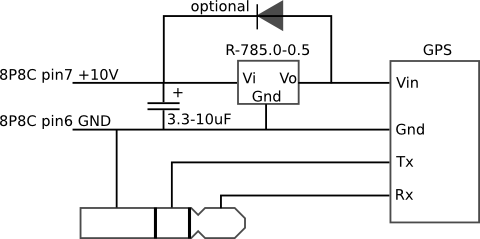
Bipolar Regenerative receiver
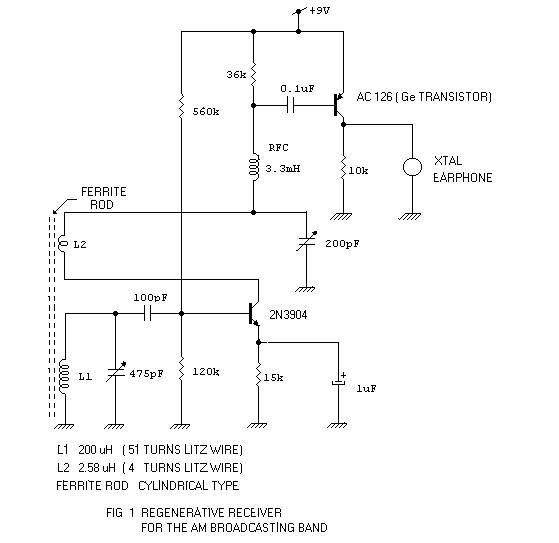
Contrary to the beliefs of some radio experimenters, a bipolar regenerative design can be made to operate efficiently. The primary concern is the low input impedance of the detector-amplifier bipolar stage; however, this can be effectively compensated with positive feedback or regeneration. Adequate regeneration can lead to remarkable tuning capabilities. Another issue is the subjective quality of the detected audio, which can vary from person to person. It is recommended that individuals evaluate the audio quality themselves. The following schematic is designed for the AM Broadcasting Band, covering frequencies from 530 kHz to 1650 kHz. The 475 pF variable capacitor is used for tuning into stations, while the 200 pF variable capacitor regulates regeneration and is referred to as the throttle capacitor. L2 serves as the tickler coil. For regeneration to occur, L1 and L2 must be correctly phased, which is crucial. The circuit operates with low power consumption; the 2N3904 transistor draws approximately 60 µA from a 9-volt battery, while the AC126 consumes about 0.5 mA. As a reference, medium-powered local stations (5 to 10 kW) within 25 km are received with audio signals rated from fair to loud. The audio output stage does not require external bias due to the leakage collector current (approximately 0.5 mA in the prototype), which is sufficient to establish a usable Beta (current amplification factor) in the germanium AC126 transistor. This configuration is somewhat unconventional but functions effectively. The signal detection is performed by the 2N3904 transistor, which operates in its non-linear region due to regeneration, effectively acting as an amplifier-detector.
The described circuit utilizes a bipolar regenerative design that capitalizes on the principles of feedback and regeneration to enhance performance in the AM broadcasting range. The low input impedance of the detector-amplifier stage is addressed through the implementation of positive feedback, which allows for greater efficiency and sensitivity in signal detection. The choice of components, such as the 2N3904 and AC126 transistors, is crucial for achieving the desired performance characteristics.
The tuning mechanism is facilitated by a variable capacitor of 475 pF, enabling the user to select specific frequencies within the AM band. The additional 200 pF throttle capacitor plays a vital role in managing the regeneration process, which is essential for maintaining stability and clarity in the received audio signals. The tickler coil (L2) is strategically positioned to enhance the feedback loop, ensuring that the regeneration is optimized for effective signal reception.
Power consumption is notably low, making this circuit suitable for battery-operated applications. The current draw of the 2N3904 at 60 µA and the AC126 at 0.5 mA demonstrates the efficiency of the design, allowing for extended operation without frequent battery replacements.
In terms of audio output, the circuit exhibits a unique characteristic where the leakage current from the AC126 transistor provides sufficient biasing for operation, eliminating the need for additional external biasing components. This design choice simplifies the overall circuit layout while maintaining effective performance.
The detection mechanism utilized by the 2N3904 transistor, driven into its non-linear region through regeneration, effectively allows for the amplification and detection of AM signals. This dual functionality is a hallmark of regenerative receivers, enabling the circuit to achieve high sensitivity and selectivity in varying signal conditions.
Overall, the described bipolar regenerative AM receiver circuit offers a compact, efficient solution for radio enthusiasts seeking to explore the AM broadcasting spectrum with minimal power requirements and effective signal processing capabilities.Contrary to what some radio experimenters think, a bipolar regenerative design can be made to work efficiently. The major concern is the low input impedance of the detector-amplifier bipolar stage. Nevertheless, it can be easily compensated with positive feedback or regeneration. A sufficient amount of regeneration can make tuning astonishingly sh arp. Another concern is the quality of the detected audio. This, to my knowledge, is subjective. The quality of sound coming out from an earphone can be rated good or fair by two different people. I would suggest that you decide by yourself. So, come on and try the following schematic for the 530 kHz to 1650 kHz AM Broadcasting Band. Please notice that the 475 pF variable capacitor tunes in the stations whereas the 200 pF variable capacitor controls regeneration. The latter is known as the throttle capacitor. L2 is the tickler coil. In order to regeneration to take place, L1 and L2 must be correctly phased ( very important! ). The power consumption is very low. The 2N3904 drains some 60 uA from the 9 volt battery and the AC126, about 0. 5 mA. As a benchmark, medium powered ( 5 to 10 kw ) local stations within 25 km from my site are heard as fair to loud audio signals.
The audio output stage has no external bias, and doesn`t need any. This is because Iceo, the leakage collector current ( about 0. 5 mA in my prototype ), is sufficient to build up a usable Beta ( or current amplifying factor ) in the germanium AC126 transistor. This is a bit unusual but it works fine. Also, the signal detection is carried out by the 2N3904 transistor, as it is driven, thanks to regeneration, into its non-linear region.
In other words, it works as an amplifier-detector. 🔗 External reference
The described circuit utilizes a bipolar regenerative design that capitalizes on the principles of feedback and regeneration to enhance performance in the AM broadcasting range. The low input impedance of the detector-amplifier stage is addressed through the implementation of positive feedback, which allows for greater efficiency and sensitivity in signal detection. The choice of components, such as the 2N3904 and AC126 transistors, is crucial for achieving the desired performance characteristics.
The tuning mechanism is facilitated by a variable capacitor of 475 pF, enabling the user to select specific frequencies within the AM band. The additional 200 pF throttle capacitor plays a vital role in managing the regeneration process, which is essential for maintaining stability and clarity in the received audio signals. The tickler coil (L2) is strategically positioned to enhance the feedback loop, ensuring that the regeneration is optimized for effective signal reception.
Power consumption is notably low, making this circuit suitable for battery-operated applications. The current draw of the 2N3904 at 60 µA and the AC126 at 0.5 mA demonstrates the efficiency of the design, allowing for extended operation without frequent battery replacements.
In terms of audio output, the circuit exhibits a unique characteristic where the leakage current from the AC126 transistor provides sufficient biasing for operation, eliminating the need for additional external biasing components. This design choice simplifies the overall circuit layout while maintaining effective performance.
The detection mechanism utilized by the 2N3904 transistor, driven into its non-linear region through regeneration, effectively allows for the amplification and detection of AM signals. This dual functionality is a hallmark of regenerative receivers, enabling the circuit to achieve high sensitivity and selectivity in varying signal conditions.
Overall, the described bipolar regenerative AM receiver circuit offers a compact, efficient solution for radio enthusiasts seeking to explore the AM broadcasting spectrum with minimal power requirements and effective signal processing capabilities.Contrary to what some radio experimenters think, a bipolar regenerative design can be made to work efficiently. The major concern is the low input impedance of the detector-amplifier bipolar stage. Nevertheless, it can be easily compensated with positive feedback or regeneration. A sufficient amount of regeneration can make tuning astonishingly sh arp. Another concern is the quality of the detected audio. This, to my knowledge, is subjective. The quality of sound coming out from an earphone can be rated good or fair by two different people. I would suggest that you decide by yourself. So, come on and try the following schematic for the 530 kHz to 1650 kHz AM Broadcasting Band. Please notice that the 475 pF variable capacitor tunes in the stations whereas the 200 pF variable capacitor controls regeneration. The latter is known as the throttle capacitor. L2 is the tickler coil. In order to regeneration to take place, L1 and L2 must be correctly phased ( very important! ). The power consumption is very low. The 2N3904 drains some 60 uA from the 9 volt battery and the AC126, about 0. 5 mA. As a benchmark, medium powered ( 5 to 10 kw ) local stations within 25 km from my site are heard as fair to loud audio signals.
The audio output stage has no external bias, and doesn`t need any. This is because Iceo, the leakage collector current ( about 0. 5 mA in my prototype ), is sufficient to build up a usable Beta ( or current amplifying factor ) in the germanium AC126 transistor. This is a bit unusual but it works fine. Also, the signal detection is carried out by the 2N3904 transistor, as it is driven, thanks to regeneration, into its non-linear region.
In other words, it works as an amplifier-detector. 🔗 External reference
